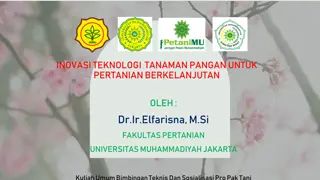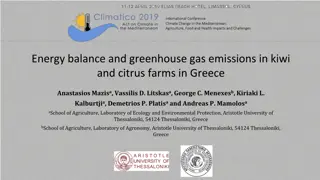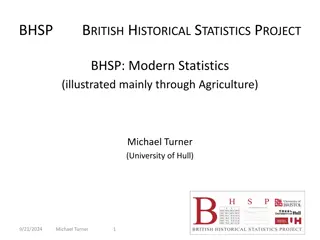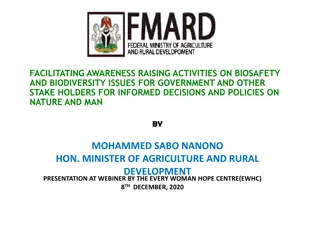Importance of Biofertilizer in Agriculture
Biofertilizers containing living microorganisms promote plant growth by enhancing nutrient availability. Blue-green algae, a type of biofertilizer, can fix atmospheric nitrogen to benefit crops. In agriculture, biofertilizers can help reduce chemical fertilizer use, restore soil health, and increase productivity in existing and potential cultivation areas. India, a major fertilizer consumer, faces challenges due to excessive chemical fertilizer use. Biofertilizers offer a sustainable solution to improve soil fertility and plant growth.
Download Presentation

Please find below an Image/Link to download the presentation.
The content on the website is provided AS IS for your information and personal use only. It may not be sold, licensed, or shared on other websites without obtaining consent from the author.If you encounter any issues during the download, it is possible that the publisher has removed the file from their server.
You are allowed to download the files provided on this website for personal or commercial use, subject to the condition that they are used lawfully. All files are the property of their respective owners.
The content on the website is provided AS IS for your information and personal use only. It may not be sold, licensed, or shared on other websites without obtaining consent from the author.
E N D
Presentation Transcript
BIOFERTILIZER ITS IMPORTANCE IN AGRICULTURE AND ADVANTAGES J.MYTHILI ASSISTANT PROFESSOR PG& RESEARCH DEPARTMENT OF BIOTECHNOLOGY BONSECOURS COLLEGE FOR WOMEN THANJAVUR
Organic Boost-Bio-fertilizer A Bio-fertilizer is a substance which contains living microorganisms which when applied to seed , plant surfaces .or soil colonizes the rhizosphere or the interier of the plant and promotes growth by increasing the supply or availability of primary nutrients to the host plant. Bio-fertilizer s and nutrients through the natural processes of nitrogen fixation ,solubilizing phosphorous and stimulating plant growth through the synthesis of growth promoting substances.
Blue-green algae cultured in specific media Blue green algae can be helpful in agriculture as the y have the capability to fix atmospheric nitrogen to soil.this nitrogen is helpful to the crops. Blue- green is used as a Bio-fertilizer.
Why..? Fertilizers supply essential plant nutrients ,mainly Nitrogen (N), years potash (K), And phosphorous(p) as they are removed in large quantities from the soil by each successive harvest ,increasingly high inputs of chemical fertilizers for high yield agriculture during the last 150 years has not only left our soils degraded ,polluted and less productive but also posed severe health hazards. India is the largest producer and consumer of fertilizer s in the world (after china and USA )accounting for 12./.of world production of N&P nutrients and 12.6./. Of world consumption of NPK nutrients. Out of the total of 329 Million Ha of India s geographical area ,about 114Million Ha is under cultivation .with India hurting towards overtaking china as the most populous country .meeting the increasing demand for food shall continue to be major challenge.
Further increase in production will depend on more productivity of existing areas or by bringing additional lands. presently under follow or wasteland categories under cultivation. Around 56.29 million hectares of the land area is currently categorized as wasteland or follow land that can be brought under cultivation in the future .Thus the total area under cultivation can rice to a total of 170.29 million hectares. agriculture a viable Bio- fertilizers have the potential to play a major role in making proposition here.
Importance in agriculture Bio-fertilizers can be expected to reduce the use of chemical fertilizers and pesticides. The microorganisms in bio-fertilizers restore the soil s natural nutrient cycle and build soil organic matter. Through the use of bio-fertilizers healthy plants can be grown while enhancing the sustainability and the health of the soil. They are extremely advantageous in enriching soil fertility and full filling plant nutrient requirements by supplying the organic nutrients . Bio-fertilizers do not contain any chemicals which are harmful to the living soil. Since they plant several roles a preferred scientific term for such beneficial bacteria is plant growth promoting rhizobacteria(PGPR).
Importance in Bio-fertilizer Bio-fertilizers such as Rhizobium, Azotobacter , Azospirillum and biue green algae (BGA)have been in use a long time. Azotobacter can be used with crops like wheat,maize,mustard,cotton,potato and other vegetable crop s.Azospirillum inoculations are recommended mainly for sorghum, millets, maize,sugarcane and wheat. Nostoc or Anabaena(blue green algae), fix atmospheric nitrogen and are used as inoculations for paddy crop grow both under upland and low-land conditions. Phosphate-solubilizing bacteria-Pseudomonas putida strain p13 are able to solubilize the insoluble phosphate from organic and inorganic phosphate sources
Types of Bio-fertilizers There are 6 types: Rhizobium Azatobacter Azospirillum BGA Azolla Phosphate solubilizing microbes
Production of bio-fertilizers Manufacturing process involves Selection of suitable strain of the organism for which market demand is identified. Mass multiplication Mixing of culture with carrier material and packing. 1. 2. 3. steps: Culture ,selection and maintenance Pure mother culture maintained in agriculture universities IARI,ICAR International source of supply NifTAL and IRRI etc., Mother culture in the test tube of designed strain can be purchased They are further sub cultured and maintained for mass production
C Culture Augmentation The culture has to be mass multiplied in to two levels : Primary level using shakers in flask 1. Secondary level in fermentors 2. Carrier sterilization: While the broth is getting ready in the fermentor the carrier material which is usuall y the carbon source for the culture in sterilized in autoclaves. 1. Mixing and packing Broth harvested from the fermentor in to sterilized carrier mixing is done manually under aseptic condition and packed in polythene bags of desired. 1.
Benefits Since a bio-fertilizer is technically living it can symbiotically associate with plant roots .Involved microorganisms could readily and safety convert complex organic material in simple compounds so that plants are easily taken up. Microorganism function is long duration causing improvement of the soil fertility It maintains the natural habitat of the soil It increases crop yield by 20-30 % Replaces chemical Nitrogen and Phosphorus by 25 % By stimulate s plat growth It provide protection against drought and some soil borne diseases Bio-fertilizers are cost effective relative to chemical fertilizer It is environmentally friendly in that it not only prevents damaging the natural source but also helps to some extent cleanse the plant from participated chemical fertilizers.
M Mycorrhizal fungi benefit host plants by: Increasing physiological absorbing surface area of the root system. Increases ability of plant to absorb water and nutrients such as N,P or other essential elements from soil. Increased tolerance of plant to drought .high salt temp. and extreams of soil acidity Due to metals like S, Mn , Al. Provide protection from certain plant pathogenic fungi and nematodes that attack roots. Bio-fertilizers offer a huge potential for wide spread use offering both economic and environmental advantage to farmers /growers and commercial viability to production units.
Bio-fertilizers:Indian scenario The Gazette of India (2006) defines Bio-fertilizers a product containing carrier based (solid or liquid) living micro-organisms which are agriculturally useful in terms of nitrogen fixation , phosphorus solubilization are nutrient mobilization so as to increase the productivity of the soil/and crop. Phosphorus deficiency: One of the major limiting factors in crop growth and nitrogen fixation in the tropical regions . Phosphorous is a non-renewable costly input often in short supply . Phosphate fertilizers also have pollution problems associated with them . In soils with high pH a major portion (75% phosphatic fertilizer)of the fertilizer applied becomes non usable(fixed)through chemical reactions inaccessible to plants. Presently in India .there is an annual demand of approximately 47.98lakh tonnes of phosphatic fertilizers for agriculture application.
M Mycorrhizal technology Successful technology capable of wasteland reclamation and beneficial in agriculture because it provides phosphorus nutrition to the plant. Mycorrhizal fungi can utilize phosphorus from extremely low concentrations . Mycorrhizal technology is an innovative invention offering a partial substitute to Chemical fertilizers as it enables plants to thrive better and offers better establishment and enhanced yield in nutrient poor conditions. There are several types of Bio-fertilizers now being marketed in India .some of the prominent ones are Rhizobium, Azatobacter ,and Azospirillum.The Indian council for Agriculture Research department of Biotechnology have actively encouraged application of rDNA technology for better quality Rhizobium and Azatobacter
In India comparable countries most commercial organic fertilizers are not covered By national or international standards .such as those which govern the quality of chemical fertilizers. Quality standards have been notified by BIS and regulator testing is also done by NBDC/RBDC and state government Laboratories .the Government of India .vide its Gazette extraordinary (part II-section 3-subsection (ii)dated 24 March 2006,released the specifications for Biofertilizers ,along with their tolerance limit and method analysis . However ,this limited to Rhyzobium, Azatobacter, Azospirilum and phosphate solubilizing bacteria (PSB) only and there is quality control of commercial microbial inoculants is n Extremely important for developing faith among the user Community regulatio Qand























